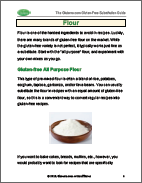Submitted by Kayo on April 1, 2013
 We had a family get together this weekend. Because Andrew doesn't eat gluten, dairy, or eggs, he usually gets special dishes that contain fewer ingredients than the rest of us. For example, a serving of mashed potatoes was set aside for him before butter and milk was added.
We had a family get together this weekend. Because Andrew doesn't eat gluten, dairy, or eggs, he usually gets special dishes that contain fewer ingredients than the rest of us. For example, a serving of mashed potatoes was set aside for him before butter and milk was added.
This time, one of our family members took on the challenge of making gluten-free pasta salad for the entire family.
She went through the trouble of seasoning the pasta salad from scratch since many people's stomach on a gluten-free diet doesn't do too well with pre-packaged seasoning. She also added lots of roasted vegetables to the pasta which was an excellent touch and added a lot to the taste. The taste was great, but the texture of the pasta was pretty typical for cold gluten-free pasta — typically a little harder and crumblier than the gluten variety. She thought it was because she didn't cook the pasta long enough, but the problem has nothing to do with the cook or the cooking, the problem is with gluten-free pasta in general.
I have yet to find gluten-free pasta that stays soft and chewy when it's cold. After all it's the gluten in pasta that gives it that soft and chewy texture. Without gluten, the pasta just doesn't stay soft. If you don't eat the pasta while it's still warm, the noodles tend to start breaking into pieces and the texture becomes harder and a little crumbly. Gluten-free pasta doesn't reheat very well either, although re-heated gluten-free pasta is much better than cold gluten-free pasta.
I usually cook gluten-free spaghetti and serve it right way with marinara sauce or clam sauce (I will post my clam pasta recipe soon). We have tried several different brands of gluten-free pasta, and this Ancient Harvest Quinoa Pasta is our favorite so far:
Recently, I decided to try bionaturae Organic Spaghetti because I read great reviews online. It wasn't bad, but we weren't crazy about it. Also, I tasted potatoes when I ate it, maybe because I read that one of the ingredients was potatoes. I guess tasting potatoes is not necessarily a bad thing if you like potatoes. For me, the issue was more with the texture than the taste. We may give it another try just to be sure.
Each gluten-free pasta is slightly different in both texture and taste, so you just have to try several different brands and find your favorite brand.
While we are on the gluten-free pasta subject, I have a few cooking tips to share since the gluten-free pasta cooks a little differently than the regular pasta.
1. Most importantly: You need plenty of water. Put more water than you think you need in the pot. The pasta should have plenty of room to move around in the water. The cooking pot should be large enough to submerge all the pasta (or most of the pasta if cooking long noodles such as spaghetti). I find it difficult to break the Ancient Harvest's noodles into two, but if you can break the long noodles into two, that might be the best approach for spaghetti and other long pasta . Just keep it in mind that unlike the regular pasta, you have to cook the gluten-free noodles for a couple of minutes before they are soft enough to bend them. If the noodles are sticking out from water too much, you may end up with unevenly cooked noodles.
2. Another very important point: Do not put the pasta until the water is rapidly boiling. If the water is not hot enough, he outer layer of pasta will start melting before the center has a chance to cook.
3. You need to put olive oil in the water so the pasta won’t stick together.
4. After you put the pasta in the boiling water, stir constantly for a few minutes or the pasta will stick together. It may look like the pasta is melting, but it is not (…well, maybe a little). The water turns really cloudy, but that's normal.
5. Lastly, DO NOT over-cook the pasta. Gluten-free pasta should always be served al dente only. Otherwise, the pasta will disintegrate in water before you have a chance to eat it! Read the manufacturer's suggested cooking time as a guideline.
Although I am not gluten sensitive, I like gluten-free pasta as much as regular pasta. I don't even bother to buy regular pasta anymore.
- Login to post comments


 Click here to get a FREE GF Substitution Guide!
Click here to get a FREE GF Substitution Guide! 
 Sign-up to become a part of our gluten-free community. As a gift for being a free member, you can download our Gluten-Free Substitution Guide -- over 40 pages of great gluten-free substitutes. As a member, we will also send you our latest updates, recipes, and special offers. We'll try not to bug you and we won't share your info.
Sign-up to become a part of our gluten-free community. As a gift for being a free member, you can download our Gluten-Free Substitution Guide -- over 40 pages of great gluten-free substitutes. As a member, we will also send you our latest updates, recipes, and special offers. We'll try not to bug you and we won't share your info.

